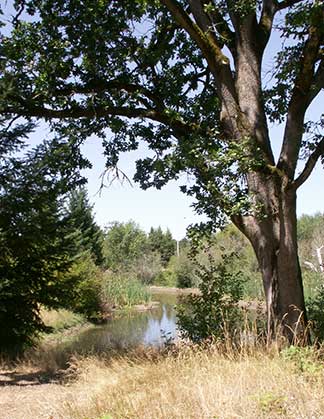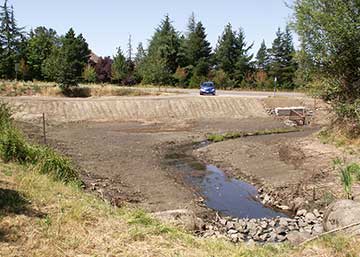 |
Previous Issues |
| Cedar Mill Community Website |
|
Search the Cedar Mill News: Search the Cedar Mill News
|
About The Cedar Mill News |
|
|||||||
| Volume 17, Issue 9 | September 2019 |
||||||
Cedar Mill Wetlands: An Update
|
|||||||||||
 |
| In February 1997, as the project began, the Cedar Mill Wetland wasn't very pretty. White sticks supported saplings. |
Over the past few decades, Cedar Mill’s two big wetland areas have undergone a great amount of change, and on multiple occasions, have been damaged and restored. Today, the wetlands go relatively unnoticed to the many who pass by the properties on a daily basis. Nevertheless, they have been important to wildlife that actively use the areas, as well as serving important functions in improving the quality of our water. So where do we stand with the wetlands? How did they become what they are today?
Wetlands play a big role in the health and habitability of our environment. They serve a handful of important purposes that affect the way we live. A wetland can hold water in order to slow the runoff and prevent flooding, and also purify the surface water. Wetlands can prevent erosion caused by storms and flooding by binding or stabilizing the soil. Lastly, wetlands are also capable of filtering water by removing sediments and chemicals that flow from yards and roads into storm drains, reducing the need for purification. Often, this can be the sole purpose for the creation of an artificial wetland.
 |
| The Saltzman wetland, viewed from the end of the path |
The Cedar Mill wetland, located in the center of Cedar Mill, is a sixteen-acre property along Barnes Road. It had historically been a wetland, but in the early 1900’s the land was drained to become a horse pasture and was later used for agricultural purposes. Then, in the 1980’s, the Cedar Mill Wetland faced unavoidable consequences from the establishment of the Sunset Transit Center and the realigning of Barnes Road. Due to the cooperation of multiple organizations, it was again converted into a wetland and, soon after, was acquired by The Wetland Conservancy. Ever since, the organization has maintained and protected the wetland.
The Saltzman wetland, located on the east side of Saltzman Road, is privately owned by the Bauer Oaks Homeowners Association, but is maintained and protected by Clean Water Services. The wetland was constructed originally as a requirement for development of Bauer Oaks. It is primarily used to improve water quality by filtering pollutants from stormwater that runs off the impermeable surfaces—roofs and roads—in the upstream developments The Saltzaman wetland is funded by ratepayers and preserved by the Clean Water Service.
 |
The Cedar Mill Wetland has a path that goes from the northwest part of Corby Drive to Barnes Road which people are welcome to walk and bike on. The Saltzman wetland also has a small trail along the south side of the property, however, since the Saltzman wetland is privately owned and resides on private property, the use of the trails around this wetland is up to the Homeowners Association. When asked in 2015 by the Cedar Mill News regarding walking on trails around the Saltzman Wetland, Steve Keenon, the Surface Facilities Maintenance Supervisor for Clean Water Services, stated that, “This is private property so any discussion of trails would be up to the HOA”.
It is worth noting that the Saltzman wetland has had its fair share of problems and setbacks in the past. In 2015, during heavy rains, the wetland overflowed and flooded Saltzman. Steve Keenon, CWS technician, noted that, “detention facilities are intended to hold high water and meter it out slowly, but this older facility was not functioning properly because three larger pipes drained to a 12" pipe. The problem was compounded by the beaver (or nutria) activity.” When he was interviewed back in 2015, he talked about the solutions that Clean Water Services had to tackle the problem: “In addition to repairing the berm, our crews will install another overflow pipe to allow the area to drain better. We will also revegetate with native wetland plants and hydro-seed the disturbed areas to protect against future erosion.”
 |
| Saltzman wetland under construction |
The Wetland Conservancy has relied on volunteers in the community to help maintain and protect The Cedar Mill Wetland. In the past, the organization sponsored restoration parties for community residents to aid in the effort of removing invasive plants and replacing them with new native species. In the past, students have also aided in this effort and the wetland has drastically changed from when restoration work initially began. Remember the white sticks that were visible in the early days? Vibrant vegetation now fills the wetland.
 |
| Restoration was done in waders in the early days of the projectvegetation |
The wetlands have become a habitat for wildlife in the community. Among the many animals that actively use the wetlands are deer, reptiles, many species of birds, amphibians, and beavers. In addition to the wildlife that inhabits the wetlands, the properties have turned into homes for a variety of vegetation types, which include wet meadow communities, forest upland, and scrub-shrub areas.
Over the past decades, restoration projects have turned the wetlands in Cedar Mill into beautiful areas with diverse vegetation communities and wildlife that positively impact our community on a daily basis and have historically served an important purpose in our local ecosystems. For these reasons, it is essential that they are maintained and preserved as, according to the Wetland Conservancy, nearly half of all wetlands on the mainland United States have been destroyed by development.
![]()
Like us on Facebook for timely updates
Published monthly by Cedar Mill News LLC
Publisher/Editor:Virginia Bruce
info@cedarmillnews.com
PO Box 91061
Portland, Oregon 97291
© 2018